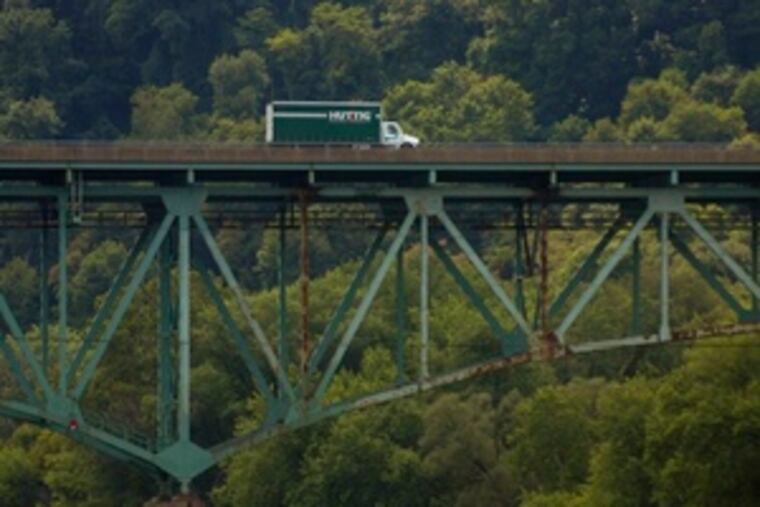3 local bridges 'deficient,' 'obsolete'
But the Delaware River spans are safe, officials said. Four upstate Pa. bridges are in "serious" condition.

The heavily used Benjamin Franklin, Walt Whitman and Tacony-Palmyra Bridges across the Delaware River are structurally deficient or functionally obsolete, according to data Pennsylvania officials released yesterday.
The bridges remain safe, officials stressed. And the agencies that own the bridges quickly challenged some of the data as outdated or inaccurate.
The three were among 54 "deck truss" bridges in the state identified yesterday as similar to the Minnesota span that collapsed in a deadly accident Aug. 1.
Two other local bridges, the Betsy Ross and Girard Point Bridges, are neither obsolete nor structurally deficient, according to the inspection data from the Pennsylvania Department of Transportation.
The Tacony-Palmyra Bridge was the only one of the five designated "structurally deficient," a rating given to bridges in need of repair, with deterioration of one or more major components. Its deck was rated "poor," a 4 on a scale of 0 to 9. The deck is scheduled to be replaced next year, bridge officials said.
The firm that conducts annual inspections for the Burlington County Bridge Commission, which owns the Tacony-Palmyra, said the 4 rating was outdated. Repairs to bridge supports last year brought the rating to 7, considered "good," said David Lowdermilk, an engineer and vice president of the firm, Pennoni Associates.
The Franklin and Whitman bridges were rated "functionally obsolete" because of their age and outdated features, but both received "fair" or better ratings for the conditions of their decks, superstructures and substructures.
Engineers grade bridges according to the condition of their primary structures. Those in "poor" or "serious" condition are of less concern to engineers than those graded as "critical" or "imminent failure." The latter designation requires a bridge to be closed.
"Our bridge engineers use these numbers to manage our system and help us decide on prioritizing bridge needs," state Transportation Secretary Allen D. Biehler said in a statement yesterday. "The numbers should not be viewed as a measure of whether a bridge is safe or not. If a bridge is open, it is safe for travel."
Biehler said the release of the data on the 54 bridges was an initial step toward providing more data on Pennsylvania's 25,000 state-maintained bridges.
After refusing for months to release the bridge-safety ratings, PennDot reversed its position last week, despite what highway officials said were internal concerns about causing undue public alarm or revealing security weaknesses.
The collapse of the Interstate 35 bridge in Minnesota prompted federal officials to ask states to reinspect bridges of similar design to that truss bridge.
The four bridges in Pennsylvania that show "serious" deterioration were identified as the eastbound and westbound spans across Six Mile Creek on I-90 in Erie County, the Donald R. Lobaugh Bridge on State Route 356 in Westmoreland County, and the Hokendauqua-North Catasauqua Bridge across the Lehigh River near Allentown.
About one-quarter of the state-owned bridges in Pennsylvania are considered structurally deficient, according to PennDot.
The five-county Philadelphia area has 602 structurally deficient bridges, 22 percent of the 2,720 state-maintained bridges in the region.
Last year, PennDot spent $558 million on 894 bridge projects. In the Philadelphia region, about $350 million in bridge construction and repair is bid each year on state-owned bridges.
And this year, the legislature approved a transportation funding bill that would provide about $530 million more per year for Pennsylvania bridges and roads.
Of the bridges identified in yesterday's release of data, only the Girard Point Bridge is owned by the state. The Franklin, Whitman and Ross bridges are owned by the Delaware River Port Authority.
The port authority and the Burlington County Bridge Commission, which pay for maintenance out of toll receipts, stressed that they considered the spans safe.
"Our bridges are safe, and our inspection, repair and maintenance programs are second to none," Burlington County Bridge Commission chairman John B. Comegno II said in a statement. "Nothing is more important to us than maintaining safe bridges for the people who use them."
The port authority said in a statement that its "bridges have been maintained in good condition in keeping with the authority's philosophy that they need to last forever."